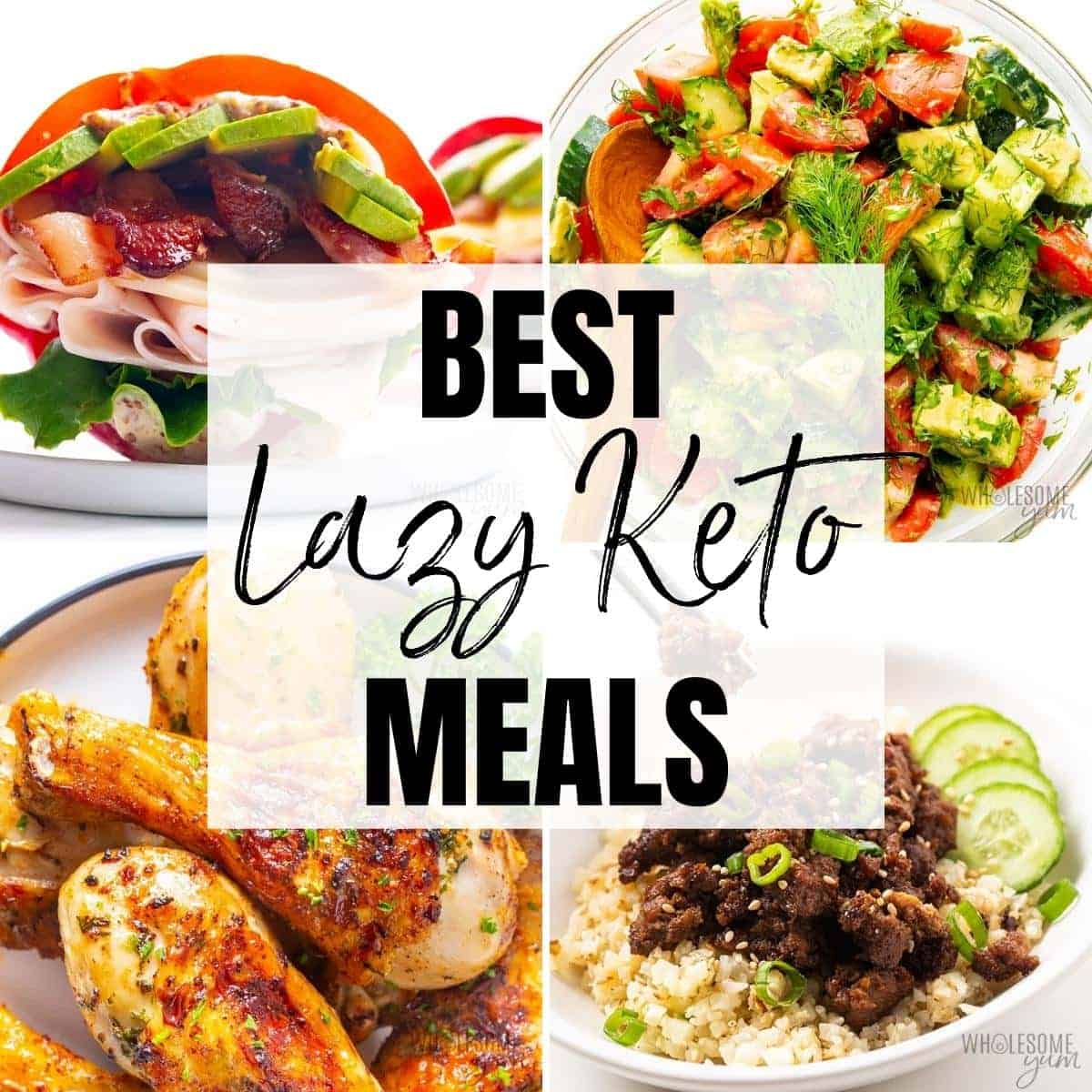Embark on a culinary journey with “The Best Low-Carb Recipes for Beginners,” your passport to a world of delicious and satisfying meals without the carb overload. This guide isn’t just about restrictive diets; it’s about unlocking flavorful dishes that are easy to prepare, even for the most novice cooks. From vibrant breakfasts to quick lunches and hearty dinners, we’ll equip you with the knowledge and recipes to navigate the low-carb lifestyle with confidence and enjoyment. Prepare to discover a new appreciation for simple ingredients and their transformative power.
We’ll explore a diverse range of recipes, covering everything from simple breakfast options perfect for busy mornings to satisfying dinners that will impress even the most discerning palates. Each recipe is meticulously crafted for ease of preparation, utilizing readily available ingredients and clear, step-by-step instructions. Beyond the recipes themselves, we’ll delve into essential low-carb cooking techniques, helping you master the art of creating delicious and healthy meals that fit seamlessly into your lifestyle. Get ready to rediscover the joy of cooking and eating!
Easy Low-Carb Breakfast Recipes
Starting your day with a delicious and nutritious low-carb breakfast can be easier than you think! These recipes are designed for beginners, focusing on simple ingredients and straightforward preparation methods. They’ll help you kickstart your day with sustained energy and keep you feeling satisfied until lunchtime.
Five Simple Low-Carb Breakfast Recipes
Below are five simple, low-carb breakfast recipes perfect for beginners. Each recipe provides a satisfying and flavorful start to the day while minimizing carbohydrate intake.
- Recipe 1: Scrambled Eggs with Spinach and Feta: This vibrant breakfast combines the richness of eggs with the earthy notes of spinach and the salty tang of feta cheese. The fluffy texture of the scrambled eggs contrasts beautifully with the slightly chewy spinach and the crumbly feta. The aroma is a delightful blend of savory eggs and slightly salty cheese.
- Recipe 2: Avocado and Bacon Breakfast Boats: Halved avocados are filled with crispy bacon, creating a satisfyingly creamy and salty breakfast. The creamy avocado offers a smooth texture, while the bacon provides a satisfying crunch. The smoky aroma of the bacon complements the mild, buttery flavor of the avocado.
- Recipe 3: Chia Seed Pudding with Berries and Nuts: This creamy pudding is packed with healthy fats and fiber, keeping you full and energized. The chia seeds create a slightly gelatinous texture, while the berries add a burst of sweetness and juicy texture. The nutty aroma of the almonds or walnuts complements the subtle sweetness of the berries.
- Recipe 4: Keto Smoothie with Coconut Milk and Protein Powder: This smoothie offers a refreshing and quick breakfast option. The creamy coconut milk blends seamlessly with the protein powder, creating a smooth, thick texture. The subtle sweetness of the coconut milk is enhanced by the addition of berries or other low-carb sweeteners.
- Recipe 5: Breakfast Sausage and Cauliflower Hash: This hearty breakfast combines savory sausage with roasted cauliflower. The cauliflower offers a tender texture that absorbs the flavors of the sausage, creating a satisfyingly savory and slightly spicy dish. The aroma of roasted cauliflower and sizzling sausage is intensely appetizing.
Detailed Recipe Instructions and Nutritional Information
The following provides detailed instructions for each recipe, along with a nutritional comparison table (approximate values). Remember that nutritional information can vary based on specific ingredients and portion sizes.
- Scrambled Eggs with Spinach and Feta:
Ingredients: 2 eggs, 1 cup spinach, 1 oz feta cheese, 1 tsp olive oil.
Instructions: Sauté spinach in olive oil. Whisk eggs and pour over spinach. Scramble until cooked through. Crumble feta on top. - Avocado and Bacon Breakfast Boats:
Ingredients: 1 avocado, 2 slices bacon, salt and pepper to taste.
Instructions: Cook bacon until crispy. Halve avocado and fill with bacon. Season with salt and pepper. - Chia Seed Pudding with Berries and Nuts:
Ingredients: 2 tbsp chia seeds, 1 cup unsweetened almond milk, ½ cup berries, 1 tbsp chopped nuts.
Instructions: Combine chia seeds and almond milk. Refrigerate overnight. Top with berries and nuts before serving. - Keto Smoothie with Coconut Milk and Protein Powder:
Ingredients: 1 cup coconut milk, 1 scoop protein powder, ½ cup berries (optional).
Instructions: Blend all ingredients until smooth. - Breakfast Sausage and Cauliflower Hash:
Ingredients: 4 breakfast sausages, 1 head cauliflower, 1 tbsp olive oil, salt and pepper to taste.
Instructions: Chop cauliflower into small florets. Roast cauliflower with olive oil, salt, and pepper until tender. Cook sausages. Combine roasted cauliflower and cooked sausages.
| Recipe | Calories (approx.) | Carbs (approx. g) | Protein (approx. g) | Fat (approx. g) |
|---|---|---|---|---|
| Scrambled Eggs with Spinach and Feta | 200 | 3 | 15 | 15 |
| Avocado and Bacon Breakfast Boats | 350 | 5 | 10 | 30 |
| Chia Seed Pudding with Berries and Nuts | 250 | 10 | 5 | 20 |
| Keto Smoothie with Coconut Milk and Protein Powder | 300 | 5 | 25 | 20 |
| Breakfast Sausage and Cauliflower Hash | 400 | 10 | 20 | 30 |
Satisfying Low-Carb Snacks and Treats

Embarking on a low-carb journey doesn’t mean sacrificing deliciousness. These recipes offer satisfying snacks and desserts that will keep your cravings at bay while staying true to your dietary goals. Each recipe highlights the delightful interplay of textures and flavors, ensuring a truly enjoyable low-carb experience.
The following recipes demonstrate how easily you can adapt low-carb treats using various sweeteners, showcasing the versatility of low-carb baking and snacking. Remember to always check nutritional information for your specific ingredients.
Five Satisfying Low-Carb Snack and Dessert Recipes
Here are five recipes, each designed to deliver both flavor and satisfaction while keeping carbohydrate intake low. The recipes highlight different textures and flavor profiles to offer variety.
- Avocado Chocolate Mousse: This decadent mousse boasts a creamy, rich texture, surprisingly achieved with the healthy fats of avocado. The intense chocolate flavor is balanced by a hint of sweetness, creating a delightful contrast. The sweetness can be adjusted using different low-carb sweeteners, like erythritol or stevia, to your preference. Imagine a velvety smooth, intensely chocolatey dessert that melts in your mouth, leaving you feeling satisfied, not guilty.
- Almond Flour Brownies: These fudgy brownies offer a satisfyingly chewy texture and intense chocolate flavor, thanks to the almond flour base. The slight nuttiness of the almond flour complements the richness of the chocolate. Experiment with different low-carb sweeteners, such as monk fruit or xylitol, to fine-tune the sweetness level. Picture rich, dark squares, intensely chocolatey with a slightly chewy texture, a perfect indulgence.
- Coconut Flour Pancakes: These fluffy pancakes have a slightly sweet and subtly coconutty flavor, thanks to the use of coconut flour. Their light and airy texture is a welcome change from heavier low-carb alternatives. Stevia or a blend of erythritol and stevia would be ideal sweeteners, enhancing the delicate coconut flavor. Visualize light and fluffy pancakes, slightly golden brown, with a delicate coconut aroma, a perfect low-carb breakfast or snack.
- Macadamia Nut Butter Cups: These delightful cups offer a delightful crunch from the macadamia nuts, combined with the creamy richness of the nut butter. The sweetness can be adjusted using your preferred low-carb sweetener, like allulose or sucralose, to create your ideal level of sweetness. Picture small, perfectly formed cups, filled with creamy macadamia nut butter, offering a satisfying crunch and creamy texture.
- Chia Seed Pudding with Berries: This refreshing pudding boasts a smooth, creamy texture from the chia seeds, perfectly complemented by the juicy sweetness of the berries. The subtle sweetness of the chia seeds can be enhanced with a touch of stevia or erythritol. Imagine a vibrant, colorful pudding, with the smooth creaminess of the chia seeds balanced by the tartness of the berries, a refreshing and healthy treat.
Adapting Recipes with Different Low-Carb Sweeteners
The sweetness of each recipe can be adjusted based on personal preference and the specific low-carb sweetener used. Different sweeteners have varying levels of sweetness and aftertaste, so experimentation is key. For instance, erythritol tends to have a cooling effect, while stevia can have a slightly bitter aftertaste if used excessively. Monk fruit offers a clean sweetness. The best approach is to start with a smaller amount of sweetener and gradually increase it until you reach your desired level of sweetness.
Portion Sizes for Low-Carb Snacks and Treats
Understanding proper portion sizes is crucial for maintaining a low-carb lifestyle. Overindulgence, even with low-carb treats, can hinder progress.
- Avocado Chocolate Mousse: 1/2 cup. Imagine a small, elegant dessert bowl filled with this luxurious mousse.
- Almond Flour Brownies: 1-2 small squares (approximately 1 ounce). Picture a neatly cut portion of a brownie, the perfect size for a satisfying treat.
- Coconut Flour Pancakes: 2 small pancakes. Visualize two perfectly golden-brown pancakes, stacked neatly.
- Macadamia Nut Butter Cups: 2-3 cups. Imagine a few small, bite-sized cups, perfectly formed and ready to enjoy.
- Chia Seed Pudding with Berries: 1 cup. Picture a tall glass filled with the vibrant pudding, layered with colorful berries.
Beginner’s Guide to Low-Carb Cooking Techniques
Embarking on a low-carb journey often involves mastering new cooking techniques to create delicious and satisfying meals. This guide will equip you with three fundamental methods—stir-frying, roasting, and slow cooking—to help you navigate the world of low-carb cuisine with confidence. We’ll also explore common pitfalls beginners encounter and provide practical solutions, followed by a sample weekly meal plan with simple, step-by-step recipes.
Stir-Frying: A Quick and Flavorful Approach
Stir-frying is a fast and versatile technique perfect for low-carb cooking. It involves quickly cooking ingredients in a wok or large skillet over high heat with a small amount of oil or fat. This method preserves nutrients and creates a vibrant, flavorful dish. The key is to use thinly sliced or chopped vegetables and protein to ensure even cooking.
For example, a classic low-carb stir-fry might feature thinly sliced chicken breast, broccoli florets, bell peppers, and a savory sauce made with soy sauce (low-sodium), ginger, and garlic. The high heat sears the ingredients, creating a slightly caramelized exterior and tender interior. Imagine the glistening chicken, the vibrant colors of the vegetables, and the fragrant steam rising from the wok. The entire dish is ready in under 15 minutes.
Roasting: Bringing Out the Best in Vegetables and Proteins
Roasting is a simple yet effective technique that enhances the natural flavors of vegetables and proteins. It involves placing ingredients on a baking sheet and cooking them in a preheated oven. The high heat creates a crispy exterior and tender interior, making it ideal for vegetables like cauliflower, Brussels sprouts, asparagus, and meats like chicken thighs and salmon.
For instance, a roasted chicken and asparagus dish begins with tossing chicken thighs and asparagus spears with olive oil, salt, pepper, and herbs like rosemary and thyme. Then, arrange them on a baking sheet and roast in a preheated oven at 400°F (200°C) for approximately 25-30 minutes, or until the chicken is cooked through and the asparagus is tender-crisp. Visualize the golden-brown chicken skin, the vibrant green asparagus spears with slightly charred edges, and the tantalizing aroma filling your kitchen.
Slow Cooking: The Ultimate in Convenience and Flavor
Slow cooking is a gentle method that allows ingredients to simmer in liquid for an extended period, resulting in incredibly tender and flavorful dishes. This technique is ideal for tougher cuts of meat and dense vegetables, transforming them into melt-in-your-mouth delicacies. The low and slow cooking process also minimizes nutrient loss.
A classic example is a slow-cooked beef stew with hearty low-carb vegetables like carrots, celery, and mushrooms. The beef, usually a tougher cut like chuck roast, is browned first before being added to the slow cooker with the vegetables and a flavorful broth. After cooking on low for 6-8 hours, the beef becomes incredibly tender, and the vegetables absorb the rich flavors of the broth. Imagine the rich, dark brown gravy coating the tender beef and the soft, flavorful vegetables. The aroma alone is enough to make your mouth water.
Common Beginner Mistakes and Solutions
Beginners often make certain mistakes when transitioning to low-carb cooking. One common mistake is using too much oil or fat, leading to excessive calories. The solution is to use cooking sprays or opt for healthy fats like olive oil or avocado oil sparingly. Another common mistake is overcooking vegetables, resulting in mushy textures. The solution is to cook vegetables until tender-crisp, maintaining a slight bite. Finally, inadequate seasoning can lead to bland meals. The solution is to experiment with herbs, spices, and flavorful sauces to enhance the taste of your low-carb dishes.
Creating a Simple Low-Carb Meal Plan
This sample weekly meal plan provides simple, step-by-step recipes and portion sizes. Remember to adjust portion sizes based on your individual caloric needs.
Day 1: Stir-fried Chicken and Broccoli: Dice 1 cup chicken breast, 2 cups broccoli florets, and 1/2 cup sliced bell peppers. Stir-fry in 1 tbsp olive oil until chicken is cooked through and vegetables are tender-crisp. Season with soy sauce, ginger, and garlic. Portion: 1.5 cups.
Day 2: Roasted Salmon with Asparagus: Season 4 oz salmon fillet and 1 cup asparagus spears with olive oil, salt, pepper, and lemon juice. Roast at 400°F (200°C) for 15-20 minutes. Portion: Entire fillet and asparagus.
Day 3: Slow-Cooked Beef Stew: Brown 1 lb beef chuck roast. Add to slow cooker with 1 cup chopped carrots, celery, and mushrooms, and beef broth. Cook on low for 6-8 hours. Portion: 1.5 cups.
Day 4: Repeat Day 1.
Day 5: Repeat Day 2.
Day 6: Repeat Day 3.
Day 7: Zucchini Noodles with Pesto and Chicken: Spiralize 2 medium zucchini into noodles. Toss with 2 tbsp pesto and cooked chicken breast (leftovers from Day 1). Portion: 2 cups.
Mastering low-carb cooking doesn’t have to be daunting. With “The Best Low-Carb Recipes for Beginners,” you’ve gained access to a treasure trove of simple, delicious, and satisfying recipes designed to make your low-carb journey enjoyable and sustainable. From the ease of our quick lunch ideas to the comforting flavors of our dinner options, you’ll find yourself confidently creating meals that nourish your body and delight your taste buds. Remember, the key is to experiment, adapt, and savor the delicious results. Embrace the journey, and happy cooking!
Top FAQs
Can I use alternative sweeteners in these recipes?
Yes, many of the recipes offer suggestions for substituting low-carb sweeteners like erythritol, stevia, or monk fruit. Always check the recipe notes for specific guidance.
How do I store leftovers from low-carb meals?
Store leftovers in airtight containers in the refrigerator for up to 3-4 days. Some recipes may freeze well; check individual recipe instructions.
Are these recipes suitable for vegetarians/vegans?
Some recipes are vegetarian-friendly, and adaptations can often be made. However, a completely vegan low-carb diet requires careful planning and may be more challenging.
What if I don’t have all the ingredients listed?
Many recipes offer substitutions or suggestions for alternative ingredients. Feel free to adapt based on what you have available, while maintaining the overall nutritional profile.


